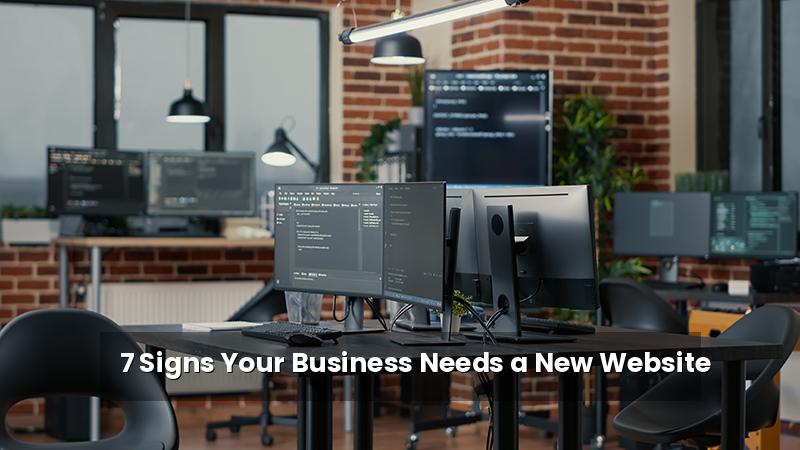7 Signs Your Business Needs a New Website
In today’s competitive digital landscape, your business website isn’t just a static online brochure; it’s your digital storefront, your lead generation engine, and often, the first impression potential customers have of your brand. But like any storefront, websites can become outdated, inefficient, or simply stop serving their purpose effectively. Ignoring these signs can cost you customers, credibility, and ultimately, revenue.
So, how do you know when it’s time to invest in a new website? It’s not always about a fresh coat of paint. Often, the reasons are deeper, impacting functionality, user experience, and your bottom line. Identifying these issues early can save you frustration and help you plan for a successful digital future.
The 7 Key Signs Your Business Website Needs an Upgrade
1. Your Website Looks Outdated and Unprofessional
First impressions matter, especially online. If your website looks like it’s stuck in the early 2010s (or even earlier!), visitors might question the credibility and modernity of your business itself. A dated design signals that your business might not be keeping up with current trends or technology. This can erode trust and cause potential customers to click away to a competitor with a more polished and professional online presence.
2. It’s Not Mobile-Friendly
This is non-negotiable in 2024. A vast majority of internet traffic now comes from mobile devices (smartphones and tablets). If your website doesn’t adapt seamlessly to different screen sizes (responsive design), users will have a frustrating experience – pinching, zooming, and struggling to navigate. Google even penalizes non-mobile-friendly sites in its mobile search results. If your site isn’t responsive, you’re losing a huge chunk of potential traffic and customers.
3. Your Website Loads Slowly
Patience is thin online. Users expect websites to load quickly, ideally within 2-3 seconds. A slow-loading site leads to high bounce rates (people leaving immediately) and damages your search engine rankings. Visitors simply won’t wait around. Investigate your loading times; if they are consistently high, it’s a major red flag that technology is outdated or poorly optimized.
4. Users Can’t Find What They Need Easily (Poor UX)
Is your website navigation confusing? Is information buried deep within layers of pages? A poor user experience (UX) makes it difficult for visitors to find products, services, contact information, or answers to their questions. If users get lost or frustrated, they won’t complete desired actions like making a purchase or filling out a contact form. An intuitive and user-friendly website guides visitors smoothly towards their goals.
5. It’s Not Generating Leads or Sales
Ultimately, your website should be a tool that supports your business goals. If it’s not converting visitors into leads or customers – if call-to-actions are missing or unclear, forms don’t work, or the user journey is broken – then it’s simply not performing its job. A high-performing website is designed with conversion in mind, guiding visitors towards specific actions that benefit your business.
6. Updating Content is a Headache
Can you easily update your website’s content? Add new products, services, blog posts, or team members without needing a developer every single time? If managing your content is a complex, time-consuming, or expensive process, your website technology is likely outdated or lacks a proper Content Management System (CMS) like WordPress. Being unable to keep content fresh and relevant impacts both user experience and SEO.
7. It’s Invisible to Search Engines (Poor SEO)
You have a great website, but can potential customers find it when they search on Google, Bing, or other engines? If your website isn’t ranking well for relevant keywords, it’s essentially hidden. Older websites often lack the technical foundation and content structure necessary for modern Search Engine Optimization (SEO). A new website built with SEO best practices in mind is crucial for organic visibility and attracting qualified traffic.
What to Do If You Spot These Signs?
Recognizing these signs is the first step. If your website exhibits one or more of these issues, it’s likely time to consider a redesign or a complete rebuild. This is an opportunity to realign your online presence with your current business goals, improve user experience, boost performance, and ensure your site is a powerful asset, not a liability. Explore how a new website can help you grow and thrive in the digital age by consulting with a web design professional.
Conclusion
Your business website is a dynamic entity that requires occasional updates and significant overhauls to remain effective. Ignoring the signs that your site is underperforming can cost you valuable opportunities. By recognizing the indicators of an outdated, non-mobile-friendly, slow, or poorly converting website, you can make informed decisions about investing in a new website design that truly supports your business growth. Think of it not as an expense, but as a crucial investment in your company’s future success and online credibility.




